Local Architect Has 'Vine Line' Vision for West Side Highway

By Shannon Ayala Laurence Tamaccio lives near the West Side Highway, the part that exposes its aged, rusty underbelly and concrete legs, held high above Riverside Park South. In his view, it's an eyesore-and he wants to cover it with vines and waterfalls. "Seeing it on a daily basis, it started to sort of wear me down aesthetically," he said. Tamaccio, an architect who describes his job as "making things that look awful look better," posted slides of his High Line-esque vision on YouTube. Trellises and ivy cover the highway's pillars from 61st Street to 72nd street in the digital image of Tamaccio's dream. Tamaccio, who lives on Riverside Boulevard, has launched a petition to achieve community support, though it hasn't circulated widely yet. Community Board 7 passed a resolution to support "continued exploration," but Tamaccio says, "The community is not as aware as it needs to be." Community Board 7 Chair Mark Diller said it's safe to say that no one finds the highway attractive. He added, "I have not heard other proposals to beautify the highway." He has heard, though, efforts to keep the highway elevated for people who use the park beneath it. Heather Lipton of 140 Riverside Blvd. said, "Vines would be gorgeous," though she hadn't considered the highway to be an issue before. "After a while you kind of get used to it," said Leslie Pilcher, 31, of West 63rd Street. Tamaccio doesn't believe painting the highway would be enough. John Hart, an artist who has lived nearby for over 20 years, disagrees. "A light blue would be better," he said, to "blend it in with the sky." The vines on the structure, he said, "would draw more attention to it." Jerry Julian, 45, who has lived in the area for several months, said he agrees with Tamaccio that the structure needs to be reworked. "I would love to do what Boston did with the Big Dig and put it underground," he said. There have been efforts to rebuild the highway underground. It was originally elevated from 72nd Street to Chambers Street but a downtown section collapsed in 1973, leading to a project called "Westway," which died after years of controversy. Then there was a plan for the Trump (later Extell) developers to rebuild the park and bury the highway but necessary federal transportation funds have yet to be acquired. "People are under the impression that ultimately it's going to be underground," Tamaccio said. There is space for a tunnel, but after Hurricane Sandy sent Hudson River water onto the park, Tamaccio thinks it's less likely the tunnel will ever be built. There are skeletal ramps from the old highway, protruding from the new one above the park south of 72nd Street. Tamaccio sees these shelf-like pieces as potential waterfall areas. He says the skeletal strips of old highway have preferable structure, upheld by arches. The elevated track for the 7 train in Queens also has a pleasing pattern of arches, he says, but most of the highway over Riverside Park South seems like a "patch-up" job. His plan has grown to include gray water catching systems to make use of drainage pipes and a year-round café to assist with funding-though after Sandy, the café should be elevated, he said. Drawing from how the High Line came about, Tamaccio says the next stage is to form a nonprofit organization. He's talking to experts, officials and collaborators. "It's my community and it affects thousands of other people," he said, adding, "It's part of the Manhattan greenway."